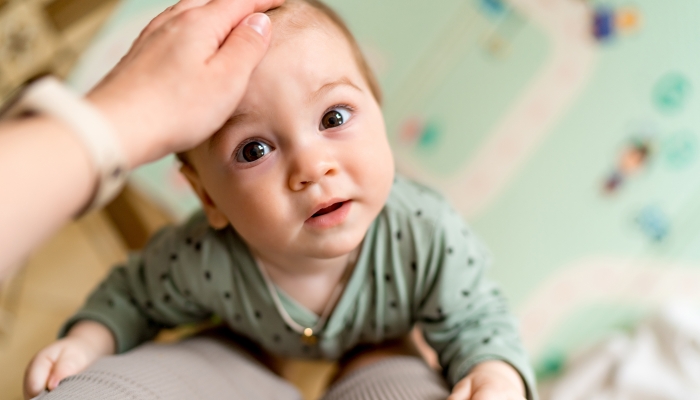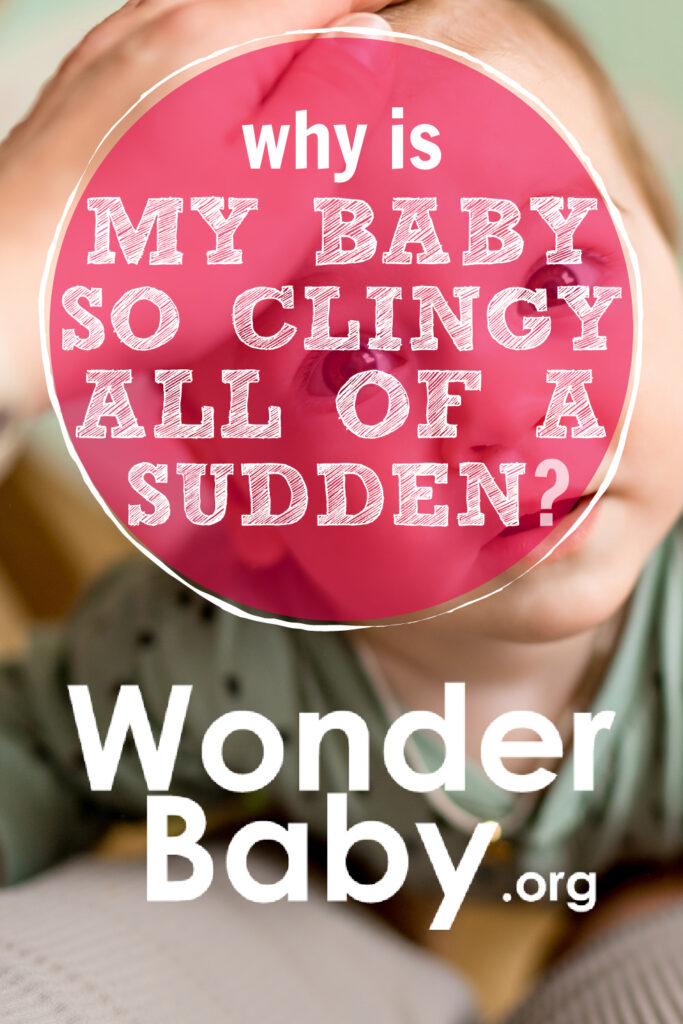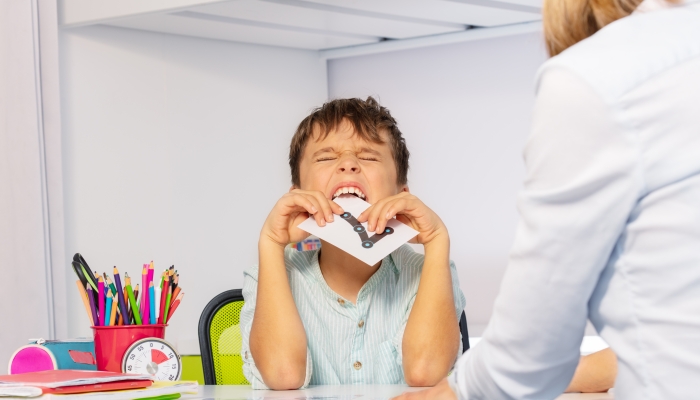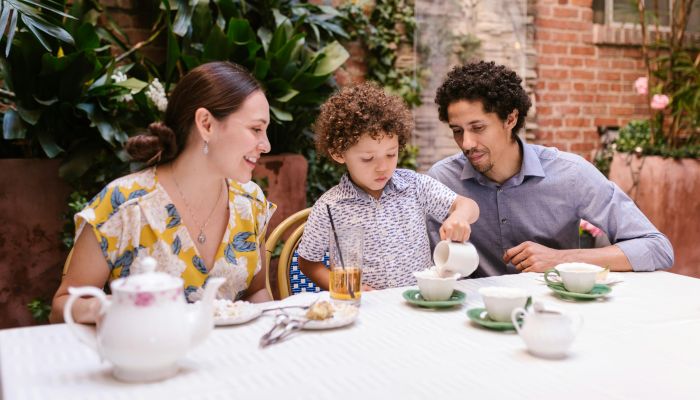Why Is My Baby So Clingy All of a Sudden?

- It’s normal for babies to become clingy suddenly.
- Changes in your child’s life, illness, or developmental growth can cause clingy behaviors.
- Many children become clingy as a result of separation anxiety.
- Many parents, though well-meaning, increase clinginess by accommodating or avoiding situations.
- Remaining calm and providing support can help reduce your child’s clingy behaviors.
You’re eight months pregnant, and your independent toddler has started to act differently. All of a sudden, she’s fearful of you leaving the room. She hugs your legs while you try to cook dinner. Every time you turn around, she’s there.
Or maybe it’s the second week of daycare, and as soon as you walk in the door your child becomes hysterical. He screams, kicks, and begs you not to leave. You reluctantly stay, unsure of what to do next.
Then you start to question whether your child is ready for daycare and contemplate alternative care options. Someone recently told you to sneak away as soon as he’s distracted, but you’re torn and unsure if you can do it.
As a parenting coach and therapist, I’ve heard these scenarios over and over. Mothers call me concerned, asking why their baby is so attached to them all of a sudden and unsure what to do.
It’s unsettling not just for your child but for you as a parent too. Here’s the good news: Your baby’s sudden clingy behavior is normal and remaining calm and consistent will help your child overcome this difficult phase.
Baby Is Clingy All of a Sudden: Should You Worry?
If it feels like your baby went from calm and independent to instantly hanging on to you and crying, remain calm. It can be perfectly normal for babies to suddenly become clingy. Sometimes this difficult stage is referred to as a “velcro baby” as it will feel like your baby is is always stuck to you.
Brain development and other major milestones occur rapidly in the first few years of life. During this timeframe, it’s common for babies to become clingy.
Babies cry to get their needs met. A parent or caregiver helps the infant, and as a result, they view the parent as a part of them.
As your baby’s brain develops, suddenly they recognize that you’re not an extension of them, but separate. Your baby always wants to be held because your child is trying to keep you, the parent, close.
Your baby relies on you for safety and comfort. Although these behaviors can be unsettling, your baby may need a little extra support, and it’s important to remain calm.

Reasons Why Babies Might Get Extra Clingy All of a Sudden
Several different things can contribute to a baby becoming clingy all of a sudden. Changes in development, stress, or a new environment can all increase a child’s clingy behavior.
Stress
Changes in the home or physical changes to your child’s body can all create stress. When stressed, infants attach to their caregivers to provide a sense of security and safety.
Changes in the home that might cause stress for your baby include:
- Starting a new daycare or school
- New pregnancy
- New sibling entering the home
- Moving
Physical changes may include teething, a toddler growth spurt, or illness. Teething can be very painful and your child might want to be held more during this time to seek comfort.
Developmental Changes
Most newborns are closely connected to their parents. Babies don’t know that their parents are not a part of them. Infants begin to recognize that their parents are separate from them around six months of age.
During this transition, most babies don’t understand object permanence. Permanence is the brain’s ability to understand that if an object or person is out of sight, they are not gone forever.
Around six months, your infant may suddenly become more attached when you leave the room because they believe that you no longer exist.
Due to rapid brain development, your baby may display difficult periods of clinginess. During a major leap in development, your baby may experience sleep regression. Your child may want to be held more or struggle with falling asleep during this time.
Separation Anxiety
As brain development continues, most infants develop separation anxiety. This is a healthy stage of development, indicating healthy attachment. Separation anxiety typically begins around 9-18 months of age but can start as early as 6 months. According to the American Academy of Pediatrics, separation anxiety is an emotional and social developmental milestone.
The following may be signs of separation anxiety:
- The child cries when a caregiver leaves.
- The child suddenly doesn’t want to play independently.
- Waking up early or sudden sleep problems.
How Long Will The Clingy Phase Last?
If your clingy child is experiencing teething or the onset of illness, rest assured that this phase typically does not last long. If your child is experiencing separation anxiety or a significant change, such as a new sibling, the clingy phase can last a couple of months or even years.

Parents Guide To Dealing With Clingy Baby
It can be exhausting when your child constantly wants to stick by your side or hang on you. Identifying the source of your child’s clinginess and following the steps below can help reduce your child’s anxiety and potentially reduce the clingy phase.
1. Identify the Source of Clinginess
When clinginess is a result of teething or illness, embrace the snuggles. Offer comfort and support during this transition.
If you need a break, but your baby is clingy, try using a baby carrier. A baby carrier will free your hands while keeping your baby close. Reaching out to your support network for a break can also be helpful.
These fussy phases typically pass in a short period of time. Try to stay calm and comfort your child.
If your child struggles with big changes in their life, during separations from you, or shows other signs of anxiety, you can support their emotional skills and mental development. Focus on supporting your child, but be careful not to accommodate or try to prevent their anxiety.
2. Provide Support
Acknowledge how your child is feeling and be supportive. Accept that your child is struggling and express confidence that your child can overcome this obstacle.
Although it feels painful to separate from your crying, clingy child, it’s important to follow through with the separation when leaving them in a safe place. As a parent, your job is not to protect your child from anxious feelings but to instill confidence that they can handle the separation. They can overcome the feeling of you leaving. They are strong.
Try to avoid judgemental or demanding statements about your child’s feelings. Instead of statements like “knock it off” or “you’re fine,” try saying: “I know you feel scared, but you are brave and I know you can do this.”
3. Maintain Your Routines—Don’t Accommodate
When children get clingy, a parent’s natural reaction is to try and avoid the situation or alter their routine to minimize the behavior. Although this is helpful at the moment it will not help your child.
If your child struggles with separation at bedtime, sometimes it feels easier to allow them to stay in bed with you. Although this might help everyone get more sleep initially, it also might inadvertently send a message that your child needs your help to sleep.
Bedtime tantrums can be exhausting but to help reduce clingy behaviors in the future, maintain the same routines. Provide supportive statements and acknowledge your child’s struggles while also instilling confidence that they can stay in their bed without you.
When a clingy toddler is suddenly struggling with separations during the day, try to offer small separations.
Create a routine of walking into another room of the house for brief periods of time. Offer supportive statements from a distance if your child becomes upset. Gradually increase the length of time you stay away. Ask friends or another family member to come over and spend brief periods with your child while you go to another room.
When leaving your child, do not try to sneak away. Instead, prepare your child for the separation. Calmly tell them you are going to leave, offer a hug, and say goodbye before walking away.
As your child cries and tries to hold on, offer supportive statements. For example, you can say “I know this is hard but you will be okay.” Do not linger or delay your departure. Be calm and reassuring, and then leave.
When to Seek Help
Remember, the sudden increase in your child holding on to you is healthy. If you are parenting a newborn, it is okay to hold your baby. You are their primary source of support. They need you.
If you find yourself exhausted or feeling unsettled by the increase in your child’s clinginess, ask your support network for help. Friends and family members can help by also holding your baby.
If you are concerned with your baby’s ability to soothe or emotional development, talk with your pediatrician.
As your child grows, remember to remain calm and offer opportunities for your child to feel safe when separated. If you feel you are making adjustments to your routine to avoid anxiety or your child’s clinginess continues to be a concern, consult your child’s pediatrician or mental health professional.

Related Posts

Behavior
Understanding Intermittent Explosive Disorder in Children
Are you worried about your child’s unexpected aggression and explosive behaviors? Learn how to support a child with intermittent explosive disorder.

Behavior
5 Emotional Regulation Activities for Kids
Want to teach your child how to regulate emotions? Here are emotional regulation activities for kids that can help!

Behavior, Special Needs
5 Tips for Dining Out with Children Who Have Sensory Sensitivities
Worried about dining out with sensory sensitivities? Try these tips for less stress and more fun the next time you take your family out to eat.